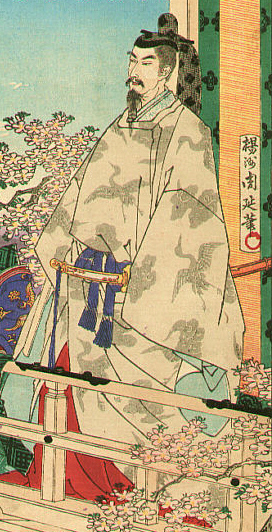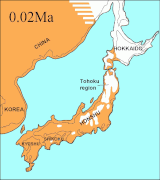Portal:Ancient Japan
The Ancient Japan Portal

The first human inhabitants of the Japanese archipelago have been traced to the Paleolithic, around 38–39,000 years ago. The Jōmon period, named after its cord-marked pottery, was followed by the Yayoi period in the first millennium BC when new inventions were introduced from Asia. During this period, the first known written reference to Japan was recorded in the Chinese Book of Han in the first century AD.
Around the 3rd century BC, the Yayoi people from the continent immigrated to the Japanese archipelago and introduced iron technology and agricultural civilization. Because they had an agricultural civilization, the population of the Yayoi began to grow rapidly and ultimately overwhelmed the Jōmon people, natives of the Japanese archipelago who were hunter-gatherers.
Between the fourth and ninth centuries, Japan's many kingdoms and tribes gradually came to be unified under a centralized government, nominally controlled by the Emperor of Japan. The imperial dynasty established at this time continues to this day, albeit in an almost entirely ceremonial role. In 794, a new imperial capital was established at Heian-kyō (modern Kyoto), marking the beginning of the Heian period, which lasted until 1185. The Heian period is considered a golden age of classical Japanese culture. Japanese religious life from this time and onwards was a mix of native Shinto practices and Buddhism. (Full article...)
Selected articles -
Topics

• Jōmon period · Japanese Prehistoric art · Jōmon Pottery
• Yayoi period
• Kofun period · Kofun · Five kings of Wa · Old Japanese language
• Emperors of Ancient Japan: Jimmu · Suizei · Annei · Itoku · Kōshō · Kōan · Kōrei · Kōgen · Kaika · Sujin · Suinin · Keikō · Seimu · Chūai · Jingū · Ōjin · Nintoku · Richū · Hanzei · Ingyō · Ankō · Yūryaku · Seinei · Kenzō · Ninken · Buretsu · Keitai · Ankan · Senka
Subcategories
WikiProjects
General images
Did you know...
- ...that in Shinto, yorishiro, such as sacred trees, attract spirits, give them a physical space to occupy and make them accessible to people for religious ceremonies?
- ...that according to a legend, the Heishi rock (pictured) represents the God of the Sea of Japan?
- ...that the stone "lions" seen at the gates of Shinto shrines are actually Chinese dogs?
Related portals
Things to do

- Peer review: None
- A-class review: None
|
- Good article nominations: Vinland Saga (TV series), Godzilla Minus One
- Add requested images to articles that need them.
- Pages for Deletion: Participate in Japan-related deletion discussions.
- Improve and expand Japan-related stubs.
- Create some requested articles.
- Help translate an article from the Japanese Wikipedia into English.
- Assess unassessed articles
Associated Wikimedia
The following Wikimedia Foundation sister projects provide more on this subject:
-
Commons
Free media repository -
Wikibooks
Free textbooks and manuals -
Wikidata
Free knowledge base -
Wikinews
Free-content news -
Wikiquote
Collection of quotations -
Wikisource
Free-content library -
Wikiversity
Free learning tools -
Wiktionary
Dictionary and thesaurus














































